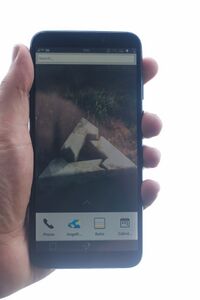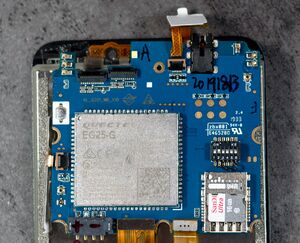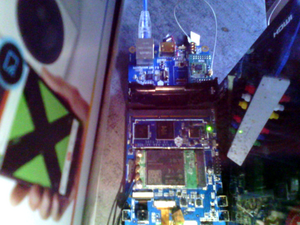PINE64 PinePhone (pine64-pinephone)
Find and report PinePhone related issues here. Keep in mind, that postmarketOS is currently in alpha state. Join the chat if you have questions.
 A PinePhone with a case | |
| Manufacturer | PINE64 |
|---|---|
| Name | PinePhone |
| Codename | pine64-pinephone |
| Released | 2019 |
| Hardware | |
| Chipset | Allwinner A64 |
| CPU | 4x 1152 MHz Cortex-A53 |
| GPU | Mali 400 |
| Memory | 2 GB |
| Architecture | aarch64 |
| Software | |
| Original software | Linux 5.3.0 |
| postmarketOS | |
| Category | testing |
| Pre-built images | no |
| Mainline | yes |
| USB Networking |
Works |
|---|---|
| Internal storage |
No data |
| SD card |
No data |
| Battery |
Works |
| Screen |
Works |
| Touchscreen |
Works |
| Multimedia | |
| 3D Acceleration |
Works |
| Audio |
Works |
| Camera |
Partial |
| Camera Flash |
No data |
| Connectivity | |
| WiFi |
Works |
| Bluetooth |
Partial |
| GPS |
Works |
| NFC |
No data |
| Modem | |
| Calls |
Partial |
| SMS |
Partial |
| Mobile data |
Works |
| Miscellaneous | |
| FDE |
Broken |
| USB OTG |
Broken |
| HDMI/DP |
No data |
| Sensors | |
| Accelerometer |
Works |
| Magnetometer |
No data |
| Ambient Light |
No data |
| Proximity |
No data |
| Hall Effect |
No data |
| Haptics |
No data |
| Barometer |
No data |
The PinePhone is a smartphone by PINE64. The postmarketOS vendor and device names are "pine64" and "pinephone" respectively. The back panel can be lifted off by pulling at the notch on the bottom-left corner of the phone. This exposes the battery, microSD and SIM slots, and dipswitches. It comes with a 3000mAh battery and uses the same form-factor as the Samsung J7 for replacement.
Contributors
Installation
| The pinephone will boot to the microSD card first if it's bootable, or the eMMC if not. |
The recommended installation procedure is installing to a microSD card by following the Installation Guide and to pass "--sdcard=/dev/(...)" to "pmbootstrap install".
postmarketOS can be installed onto the eMMC by booting a Linux distribution on the phone first and doing the installation process via pmbootstrap on the phone directly:
- Install pmbootstrap and its dependencies on the phone on any Linux distribution booted via the microSD card
- Follow the Installation Guide until "Installation and flashing"
- Run "pmbootstrap install --sdcard=/dev/mmcblk(...)"
| Note: Do not try to install from the demo image, the space of the partition in the demo image is limited. |
Installing postmarketOS on the eMMC directly from a computer via FEL is also supported,[1] it however requires a USB to Serial cable as the PinePhone does not have a dedicated FEL button. For further information see: https://linux-sunxi.org/FEL#Through_serial_console.
Serial console
The PinePhone has a serial port in the headphone connector, it's activated by the 6th contact on the dipswitch. If the switch is on then the headphone connector is in audio mode, if it's off then it's in UART mode.
The uart is 115200n8
The pinout for the serial connector on the tablet side is:
- Tip: RX
- Ring: TX
- Sleeve: GND
The serial connection is 3.3V
You can also buy the debug cable from PINE64 Store The store cable uses a 4 ring plug, as seen in the PDF, but a 3 ring plug works just as well.
Hardware switches
There's a 6 contact dipswitch on the back of the phone underneath the back cover. The 6 switches are for enableing/disableing hardware components. The switch has tiny numbers 1-6 beneath the contacts, moving the contact up sets that contact on.
| # | Off | On |
|---|---|---|
| 1 | Modem disabled | Modem enabled |
| 2 | Wifi/BT disabled | Wifi/BT enabled |
| 3 | Microphone disabled | Microphone enabled |
| 4 | Rear camera disabled | Rear camera enabled |
| 5 | Front camera disabled | Front camera enabled |
| 6 | Headphone UART mode | Headphone audio mode |
Expansion port
There is a 2x3 grid of pogo pins on the back of the pinephone for connecting a back cover with extra hardware like an extended battery case or a keyboard case. The pinout for this connector:
| Interrupt | I2C | I2C |
| 3v3 | usb 5v | gnd |
the USB5v line is meant to charge the phone and the 3v3 is to power peripherals to the phone. The I2C and interrupt lines have pull-ups on the phone side.
Components
| Component | Model | Driver |
|---|---|---|
| Touchscreen | Goodix | TOUCHSCREEN_GOODIX |
| Rear camera | OmniVision OV5640 | VIDEO_OV5640 |
| Camera flash | SGMICRO SGM3140 | LEDS_SGM3140 |
| Front camera | GalaxyCore GC2145 | Nope |
| LCD | Xingbangda XBD599 | CONFIG_DRM_PANEL_XINGBANGDA_XBD599 |
| WiFi | Realtek RTL8723CS | RTL8723CS |
| Bluetooth | Realtek RTL8723CS | BT_HCIUART_RTL |
| Modem | Quectel EC25-E | USB_NET_QMI_WWAN |
| GNSS/GPS | Quectel EC25-G | CONFIG_USB_SERIAL_OPTION |
| Magnetometer | ST LIS3MDL | IIO_ST_MAGN_3AXIS |
| Ambient light / Proximity | SensorTek STK3335 | STK3310 |
| Sixaxis | InvenSense MPU-6050 | INV_MPU6050_I2C |
| Vibration motor | ? | INPUT_GPIO_VIBRA |
| Notification LED | LED0603RGB | LEDS_GPIO |
| Volume buttons | Buttons connected to the KEYADC | KEYBOARD_SUN4I_LRADC |
| Power button | X-Powers AXP803 | INPUT_AXP20X_PEK |
| Battery fuel gauge | X-Powers AXP803 | BATTERY_AXP20X |
Cameras
The cameras both share the csi-0 bus. Currently only the rear camera (OV5640) has mainline linux support.
It's also not clear how the camera switching would work on the software side, the current issue is that the sunxi csi driver doesn't support multiple camera endpoints.
The camera hardware pipeline is controlled with /dev/media1 and media-ctl, the result is on /dev/video1
pinephone:~# media-ctl -d /dev/media1 --set-v4l2 '"ov5640 2-003c":0[fmt:UYVY8_2X8/1280x720]'
pinephone:~# ffmpeg -s 1280x720 -f video4linux2 -i /dev/video0 -vframes 1 selfie.jpg
Camera Flash
The camera flash consist out of a SG Micro SGM3140 "500mA Buck/Boost Charge Pump LED Driver" and a EHP-C04 LED.
The driver supports Flash and Torch mode, the first being brighter but only for about 300ms, when it switches to Torch mode. Torch mode is lower brightness but can be turned on continuously.
# Turn on Flash, wait 0.3s, turn off
echo 1 > /sys/class/leds/sgm3140-flash/flash_strobe
sleep 0.3
echo 0 > /sys/class/leds/sgm3140-flash/flash_strobe
# Turn on Torch
echo 1 > /sys/class/leds/sgm3140-flash/brightness
# Turn off Torch
echo 0 > /sys/class/leds/sgm3140-flash/flash_strobe
WiFi
The wifi uses the rtl8723cs driver and is functional. There is still an issue with the driver not reloading correctly when the SoC is put into suspend mode, this can be worked around by reloading the kernel module:
pinephone:~# sudo rmmod rtl8723cs
pinephone:~# sudo modprobe rtl8723cs
Bluetooth
The bluetooth connection is handled by the wifi chipset. It is functional but there is no integration in Plasma Mobile yet. To pair a bluetooth device start the bluetoothd service and use bluetoothctl to connect.
pinephone:~# sudo service bluetoothd start
pinephone:~# bluetoothctl
# scan on
[NEW] 00:11:22:33:44:55
# pair 00:11:22:33:44:55
Modem
Receiving and sending text messages works, The calls work but there are some issues left with the audio routing. Mobile data is functional.
To bring up mobile data run the following commands:
pinephone:~# sudo apk add py3-dbus
pinephone:~# sudo pip3 install ofonoctl
pinephone:~# ofonoctl wan --connect --append-dns
Sensors
All sensors work and are accessible as Industrial I/O (iio) devices in Linux. To query the data you can cat the files in `/sys/bus/iio/` to make the kernel module query the sensors
pinephone:~# cat /sys/bus/iio/devices/iio\:device0/name
mpu6050
pinephone:~# cat /sys/bus/iio/devices/iio\:device0/in_accel_z_raw
-17594
pinephone:~# echo "Verified gravity still exists"
RGB Led
# Activate LED
echo 1 > /sys/class/leds/$COLOR/brightness
# Deactivate LED
echo 0 > /sys/class/leds/$COLOR/brightness
Audio
Speakers
Sound output should work after unmuting AIF1 Slot 0 digital
See also
- pmaports!308 Initial merge request

